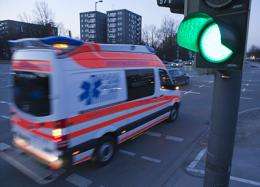Cell phone signals help manage traffic

In a pilot project in Texas, Siemens is developing intelligent transportation technology for the fast and orderly evacuation of citizens. In this project, traffic light timing systems register traffic flow and adjust the phases of red and green light accordingly. The traffic density data collected by the systems is also incorporated into digital road maps, which drivers can download onto their smartphones or navigation systems in order to find the quickest routes out of town. In an emergency, the system can centrally control all traffic lights. The U.S. Department of Transportation supports the project in its IntelliDrive program, a research initiative focused on networking vehicles and infrastructure.
The project is being conducted in Harris County, Texas, which includes the greater Houston area. With its more than four million inhabitants, Harris County is one of the most populous counties in the United States. When Hurricane Ike hit Texas in September 2008, the county was faced with the challenging task of evacuating thousands of residents in what was the third-most costly disaster in U.S. history. Intelligent traffic technology will help to make such emergency situations less challenging in the future.
For the project in Harris County, Siemens Intelligent Traffic Solutions developed an especially simple, inexpensive traffic light timing system, which estimates the number of vehicles by registering the signals emitted by the drivers’ cell phones. The associated software is supplied by Siemens’ global research unit, Corporate Technology.
Comparative tests with procedures that calculate traffic density on the basis of stationary toll tag readers, such as those used for congestion charges, have shown that the Siemens system provides reliable data even if only a few drivers have their cell phones switched on.
The system has now been installed at 400 intersections in Harris County. The organizers plan to standardize communication between emergency vehicles and the infrastructure so that traffic lights will automatically turn green whenever a fire truck, police car, or ambulance approaches. The system could even coordinate traffic lights if several emergency vehicles approach an intersection simultaneously. Siemens is currently developing such a system for testing by the U.S. Department of Transportation.
Intelligent traffic management is not only useful in emergencies, however; it also improves everyday traffic flows, reduces noise, the number of accidents and traffic jams, and benefits the environment. In cooperation with BMW, Siemens demonstrated that communication between traffic lights and engine control systems can reduce fuel consumption by, shutting off the engine just before a traffic light turns red. Intelligent traffic management is one of the key areas being addressed by Siemens’ new Infrastructure & Cities Sector, which will be operating on Oct. 1.
Provided by Siemens AG



















